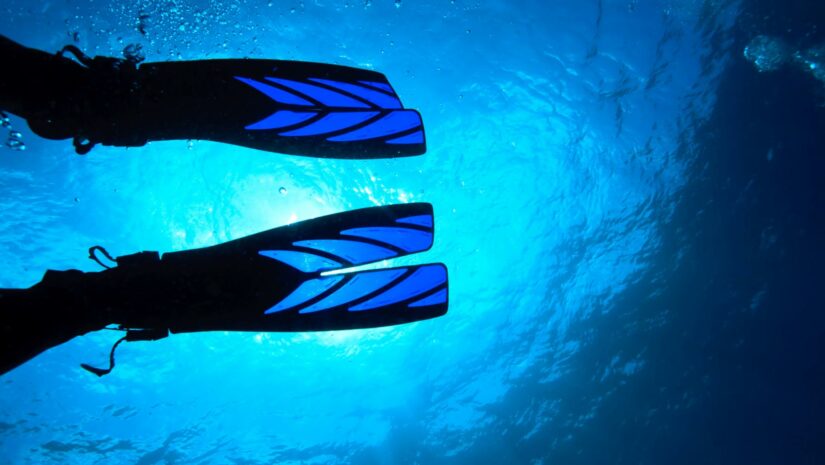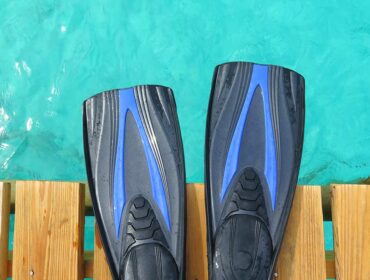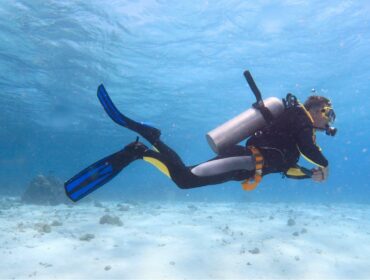If you’re new to the world of diving, you might’ve noticed that people use different types of dive fins. Some divers use blade (or paddle) fins, while others use split fins. Both fins help you move faster and easier underwater, though each type of dive fin has unique advantages and drawbacks.
Split Fins vs Regular Fins: How Are They Different from Each Other?

Split and blade fins mostly differ in propulsion power and air conservation. With this fact in mind, let’s dig a little deeper into the different characteristics of each fin type.
Power & Speed
A relatively new option for divers, split fins have the same shape as a fish’s tail with a slit down the center. This slit creates a vortex that helps divers get optimal thrusts and speed underwater instead of just pushing them forward.
Split dive fins work just like a propeller: the slit lets water flow smoothly on the upward fin stroke, resulting in a foil shape from both sides of the blade. This shape allows you to move forward through the water by producing the right lift. However, split fins won’t let you swim faster than your current speed. If you do longer, harder kicks using these scuba fins, their flow-through design gets less efficient. The design gives you less forward momentum, too.
On the other hand, blade fins are more powerful than split fins as they push water back to help you move forward through the water. Paddle fins also vary in length and stiffness—two contributing factors to speed and required kicking force. Greater stiffness gives you more forward speed, but you’ll find kicking more difficult. Scuba split fins, in contrast, don’t have the rigidity of blade fins since they’re quite light and flexible.
Efficiency
Rather than over their sides, split fins channel any surface water in and out of their opening. This process creates a spring-like action, which provides a more effective and powerful kick. Drag and effort are reduced as well, resulting in greater efficiency.
Meanwhile, blade fins experience water spills over the sides of their blades during kicks. This reaction makes these fins less efficient than their split counterparts. It also results in more drag, and you’ll need to move a lot to propel forward. All these factors give split dive fins a significant advantage over paddle fins.
Air Conservation
Upward fin strokes don’t push you forward as much as other underwater kicking and finning techniques, which makes split fins more energy-efficient in doing these kicks than paddle fins. Scuba split fins are easier to use in many scenarios since they don’t need divers to kick as hard, helping them conserve air. The same can’t be said for paddle fins as they need more kicking force. Divers end up consuming more air, which in turn shortens their dives.
Use
Since split fins are very good at energy efficiency, they’re ideal for the following people:
- Casual divers
- Inexperienced divers without a good kicking technique
- Divers with ankle or knee problems, or divers who get cramps quickly
Split dive fins offer less joint pressure and no pain while you develop the right kicking motion since your strokes will feel less powerful. These types of fins also suit divers with lower-body injuries as they’re great for muscle rehabilitation and strength. However, many divers argue that these types of fins aren’t powerful enough to combat harsh currents. That’s why split fins can be more effective in easy dive sites with little or no current.
As for blade fins, they’re suitable for more technical dives or dive sites with strong currents. That’s because paddle fins make kicks more powerful. Divers can also pick these fins if they want to chase fish at a faster speed. And if you’re a certified divemaster who might be tasked to perform a diver rescue, blade fins will suit you well. You’ll surely find these fins useful when carrying a diver to shore or to the boat since they’re great at supporting weight.
Are Split Fins Better Than Blade Fins?

To summarize the points we’ve discussed above, split fins offer more efficient thrusts and oxygen conservation. But these scuba fins have their drawbacks as well, including reduced swimming speed and kicking power. Regular fins excel in both departments as they give you stronger force underwater. You can also use blade fins in a wider variety of situations, from technical dives to rescues.
But while split fins hold some advantages over paddle fins, answering whether they’re better than the latter is tricky. In the end, your underwater needs will define your choice of dive fins. You can go anywhere in the deep blue with split and blade fins, and many divers feel comfortable using both.





